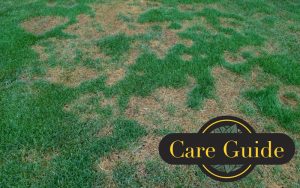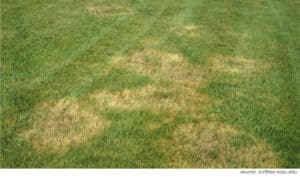
Patch Turf Disease Prevention and Control
Consider these tips for patch turf disease prevention and control. Patch fungus typically appears as circular or irregular patch of yellow or brown turf although there are variations depending on grass variety and soil type. Be aware that both prevalent types of patch disease including large and brown patch are strains of Rhizoctonia solani a fungal disease of turf grasses. The fungus is present in the soil and that layer year-round, but the disease shows only under specific environmental conditions. Symptoms develop when nighttime temperatures are between 60and 75 degrees, daytime temperatures
are below 85-90 degrees and soil temperature is 70 degrees (spring and fall). Summer heat and winter cold keep the disease at bay, but a lengthening of fall weather and frequent rains and can extend the disease from November through May. In some cases, damage may not be observed until spring when the grass begins to green. Rockaway
can help you correctly identify the cause of dying patches and lawn thinning as these can be caused by drought, nutritional deficiencies, pests and pathogens other than Large Patch. The disease spreads through spores that are easily carried by wind, water, or human activity. To control and prevent this fungal disease, it is important to manage your lawn properly. Here are some tips:
1. Avoid over-watering your lawn. Water deeply but infrequently to encourage deep root growth and discourage the growth of the fungus.
2. Water your lawn in the early morning to allow the grass blades to dry before evening, reducing conditions for fungal growth.

4. Maintain proper mowing practices. Do not remove more than one-third of the grass blade in a single mowing. Keep your lawn at the recommended mowing height for your grass species.
5. Ensure adequate sunlight reaches your lawn. Prune overhanging trees or structures that may shade the grass excessively.
6. Avoid excessive nitrogen fertilization, especially during hot and humid weather.
Patch turf disease prevention and control requires proper cultural practices including proper irrigation, mowing practices, fertilization, and attention to drainage. However, even with best cultural practices, chemical intervention may be needed.
For best results begin treatment before or at the onset disease. To keep Rhizoctonia solani in check Rockaway regularly monitors seasonal conditions and soil temperature turns to initiate timely prevention and control programs for our clients. Where Rhizoctonia solani has been previously identified, controls can be initiated early in the season. If symptoms have already begun, Rockaway can establish an aggressive program with additional billable treatments to improve the appearance of your lawn, but because symptoms do not fully subside until a change of weather brings normal turf growth, we cannot guarantee a complete improvement. You can help by communicating any changes in your lawn to your Rockaway client experience coordinator so we can work together to keep this ongoing challenge under control.
From our office in Atlantic Beach and satellites throughout Northeast Florida, Rockaway Inc proudly serves both commercial and residential landscape design, maintenance, lawn care, irrigation, and outdoor living carpentry client needs in Jacksonville, St Augustine, Atlantic Beach, Neptune Beach, Jacksonville Beach, Ponte Vedra, Nocatee, St. Johns, and Fernandina Beach.
